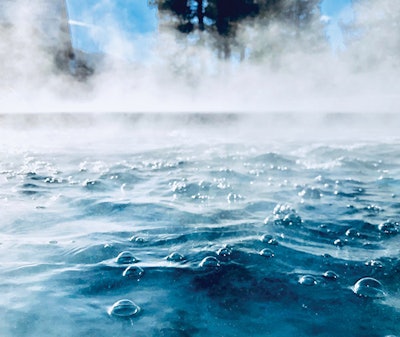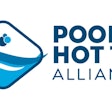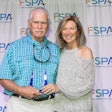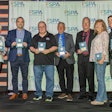
Among the many ways in which the Association of Pool and Spa Professionals serves the industry, few require as much rigor as the development of professional learning opportunities. Not only must every course and textbook keep up to date with regulatory shifts, but APSP leaders also wanted those educational materials to be available in a digital format for greater accessibility.
The sheer scope of these updates — especially on the technological side, which involved APSP approving a $1.3 million investment in e-learning tools — sometimes bogged down the system. It could be difficult to choose between polishing up lesson plans and incorporating the shiniest new digital interfaces.
Then it occurred to the members of the APSP education team that another, more ambitious strategy might work. Why not address all the needs in the pool and spa education space?
It would take diligence, creativity and intricate organization. But it would also best fulfill the organization’s overarching mission: to provide the best possible support to members.
“We promised last year that we were going to revamp all of our education materials, produce online training and create new content,” says Silvia Uribe, director of education with APSP. “We promised to do it in a timely fashion, and we delivered.”
THE MARATHON BEGINS
It helped that APSP had a strong foundation to build upon. A good educational program was already in place, but the education team recognized there were opportunities to introduce valuable upgrades. For example, integrating existing education with modern technology could create a more dynamic experience for learning. And implementing a structural approach could make it easier to make future changes.
The process began with the manuals that are very familiar to anyone who’s engaged with APSP coursework in the past. The material in the manuals was strong, but APSP wanted to be certain it was thorough and completely up to date.
APSP committees, populated by an array of industry leaders, were tapped for their expertise. They checked to make sure all information was current and filled in some gaps.
“Our manuals are the most up to date in the market right now,” says Uribe.
A BETTER COURSE
The manuals are an invaluable reference for pool and spa professionals and are potent learning tools on their own. They are also only one component of the educational offerings from APSP. Fully committed to strengthening the whole program, APSP employed the upgraded manuals as a valuable yardstick. Other educations pieces needed to measure up.
“The second thing that had to be done was update and modernize all of the in-person instructional tools to fit the updated manuals,” says Lawrence Caniglia, president and CEO of APSP. “Some of the manuals have grown substantially with a lot of new stuff in them.”
Because the manuals have also gained some weight, it was sometimes difficult to transfer all the assembled information into a classroom instruction model. APSP also received feedback indicating members would appreciate a slightly different approach to what had come before.
RELATED: The Building Blocks of Training
In the old classroom courses, all conceivable material for a specialized subject area — such as classes aimed at installers or maintenance personnel — was stuffed into the syllabus, requiring tremendous time commitments of the part of students.
What’s more, classroom instruction was locked into a pace determined by the instructor. There was no mechanism to implement minute adjustments based on individual needs. A seasoned student often had to sit through overly familiar lessons, or a comparative novice was immediately two steps behind because the instructor went too quickly.
All the information in the manuals is important, but APSP sensed there might be someone more qualified than the instructor to determine the content and the pace.
SET BY THE STUDENTS
When APSP upgraded the class-based portion of their educational programs, they took advantage of the most up-to-date technology to make it flexible for students. The new classes are completely available online, and students set their own pace. If someone wants to parcel out modules in their spare time over the course a few weeks, they can do that. If they’d rather binge it like an addictive Netflix show, that works, too.
Breaking the classes into modules also allowed APSP to organize the material into distinct, self-contained topics. That means learners can pick and choose from the educational menu depending on what they require, whether they’re brushing up on the familiar or trying to develop a whole new skill set.
The efficiency of the module approach also has economic benefits.
“You don’t have to pay for or take the whole course,” Uribe notes. “You just select the module and get the specific knowledge you need.”
The other benefit to online courses: They enable students to participate wherever they can connect to the internet, whether in the office, at home or in a favorite coffee shop. This arrangement is especially helpful for professionals who would otherwise have to travel great distances to attend in-person.
BEST OF BOTH WORLDS
Those of us who consider ourselves tech-savvy early adopters sometimes forget not everyone is as comfortable with new technology.
“We recognize that there are different learning styles and there are people who still prefer to have clear direction from an instructor,” Uribe says.
APSP is closing in on an innovative model that will merge the benefits of the online, self-paced, module-based learning with the strengths of the face-to- face sessions. Before long, all of the APSP courses will be offered in this blended format.
“So let’s say, in the typical in-classroom program, you’re in a classroom three or four days,” Caniglia explains. “With a blended program, you’re doing most of the hours online, then you’ll go to a classroom — which will typically be at a trade show or a local chapter of APSP around the country — and an instructor will come in and teach the most complex material for one day.”
RETHINKING RETAIL
A straight line can be drawn from many of the adjustments APSP made to their education program and feedback from the membership. That’s certainly true of the newest addition to the lineup: coursework designed specifically for those working on the retail end of the business.
“One of the things that we heard from our members is the need to train the retail associate,” Uribe says. “And it’s a very different audience than maintenance. These are staff that are, for the most part, seasonal.”
Although retail associates don’t need to be experts on everything, their place at the front of store means they are usually the ones customers rely on to provide answers to pressing questions.
“Retail associates need to have that pool knowledge on a very detailed level, and it needs to be accurate,” Uribe notes.
Important as those retail associates are to the overall health of a pool and spa business, the tendency for them to be short-timers in the field is a disincentive to investing a lot in their professional development. It might not be smart to ship them off to conferences to learn the trade if they’re likely to stick around for no more than a season or two.
But none of those concerns are on the customer’s mind when they’re expecting the retail associate to steer them in the right direction. Customer loyalty is critical in the industry and only growing in importance. A clerk who appears to lack knowledge erodes trust and can send a customer straight to a competitor, never to return.
RELATED: APSP Announces New and Improved Online Course
It was one of the trickier programs to develop because there were no shortcuts. Other courses began with a comfort that the learner had a basic working knowledge of the pool and spa industry. APSP assumed that retail workers were starting even before square one.
“What are the bones that a sales associate needs to know in order to perform their job well, in order to provide a good services to the customer? That’s what the course addresses,” Uribe says. “There’s also the sales component and an admin component. Those aren’t part of the other courses.”
The retail associate course includes some other fundamentals that apply to any business — customer service, basic professionalism — but it mainly covers material specific to pools and spas.
“This is an inexpensive and very good way to train new employees coming into this world,” says Caniglia. “We’ll have basically anything you need to know about the pool and spa industry in order to work in a retail store.”
APSP believes the retail associate coursework can bolster one of the most obvious advantages a brick-and-mortar established has over online upstarts.
“What’s the one thing you can get in a retail store that you’re not going to get with an online experience?” Caniglia asks. “You’re going to get a live person talking to you about your questions.”
THE SAME PAGE
The campaign to update and improve APSP education programs was so extensive that it required a small legion of people to pitch in. APSP staff members did much of the heavy lifting and information coordination, but they reached out extensively and often. “It was a national effort from all segments of the industry,” Caniglia says.
Drawing on insight from pool and spa professionals all over the industry was crucial to the success of the coursework makeover. Although the different courses are designed for different parts of the industry, all of the programs are in clear alignment. After completing APSP classes, professionals working in every part of a pool and spa business will have a shared understanding of what’s most valuable to know in the here and now.
That sense of unity was part of the goal APSP was given by the membership.
“We are going to continue listening to industry and providing what they need,” Uribe says.




















![IPSSA’s incoming President Michael Denham [left], Rose Smoot, IPSSA Executive Director [center] and the outgoing President, Todd Starner [right].](https://img.aquamagazine.com/files/base/abmedia/all/image/2024/04/New_IncomingPres_MikeDenham_RoseSmoot_outgoing_president_ToddStarner_IMG_3920_copy.662682e0cbd3a.png?auto=format%2Ccompress&fit=crop&h=100&q=70&rect=0%2C345%2C3024%2C1701&w=100)

![IPSSA’s incoming President Michael Denham [left], Rose Smoot, IPSSA Executive Director [center] and the outgoing President, Todd Starner [right].](https://img.aquamagazine.com/files/base/abmedia/all/image/2024/04/New_IncomingPres_MikeDenham_RoseSmoot_outgoing_president_ToddStarner_IMG_3920_copy.662682e0cbd3a.png?auto=format%2Ccompress&fit=crop&h=167&q=70&rect=0%2C345%2C3024%2C1701&w=250)






![IPSSA’s incoming President Michael Denham [left], Rose Smoot, IPSSA Executive Director [center] and the outgoing President, Todd Starner [right].](https://img.aquamagazine.com/files/base/abmedia/all/image/2024/04/New_IncomingPres_MikeDenham_RoseSmoot_outgoing_president_ToddStarner_IMG_3920_copy.662682e0cbd3a.png?auto=format%2Ccompress&fit=crop&h=112&q=70&rect=0%2C345%2C3024%2C1701&w=112)






